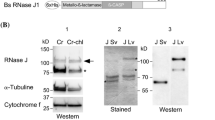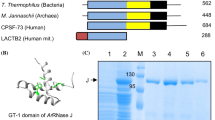Abstract
The 3′ maturation of chloroplast pre-mRNAs in Chlamydomonas proceeds via endonucleolytic cleavage, exonucleolytic trimming of the upstream cleavage product, and rapid degradation of the downstream moiety. However, the cis elements and trans factors remain to be characterized in detail. In the case of atpB, a 300 nucleotide processing determinant (PD), consisting of an inverted repeat (IR) and endonuclease cleavage site (ECS), directs 3′ maturation. To further characterize the PD, 15 variants were examined in vivo in ectopic contexts. This revealed that the IR, and nucleotides 15–37 downstream of the ECS stimulate processing. A candidate trans factor for 3′ maturation was subsequently functionally analyzed. This factor is encoded by the nuclear locus MCD4, and the mcd4 mutant was known to accumulate abnormally 3′-processed chloroplast mRNAs. When the mcd4 mutation was crossed into strains containing reporter genes with insertions of several PD versions, processing was reduced in some cases. This caused accumulation of RNA sequences downstream of the PD, which are normally degraded. From these data, it can be suggested that MCD4 facilitates the endonucleolytic cleavage step in 3′ end maturation of atpB and perhaps other mRNAs, by interacting with the IR, RNA downstream of the IR, or with proteins bound there.






Similar content being viewed by others
References
Blowers AD,Klein U, Ellmore GS, Bogorad L (1993) Functional in vivo analyses of the 3′ flanking sequences of the Chlamydomonas chloroplast rbcL and psaB genes. Mol Gen Genet 238:339–349
Bollenbach TJ, Schuster G, Stern DB (2004) Cooperation of endo- and exoribonucleases in chloroplast mRNA turnover. Prog Nucleic Acid Res Mol Biol 78:305–337
Bollenbach TJ, Stern DB (2003) Secondary structures common to chloroplast mRNA 3′-untranslated regions direct cleavage by CSP41, an endoribonuclease belonging to the short chain dehydrogenase/reductase superfamily. J Biol Chem 278:25832–25838
Boynton JE et al (1988) Chloroplast transformation in Chlamydomonas with high velocity microprojectiles. Science 240:1534–1538
Church G, Gilbert W (1984) Genomic sequencing. Proc Natl Acad Sci USA 81:1991–1995
Drager RG, Girard-Bascou J, Choquet Y, Kindle KL, Stern DB (1998) In vivo evidence for 5′-3′ exoribonuclease degradation of an unstable chloroplast mRNA. Plant J 13:85–96
Drager RG, Zeidler M, Simpson CL, Stern DB (1996) A chloroplast transcript lacking the 3′ inverted repeat is degraded by 3′ to 5′ exoribonuclease activity. RNA 2:652–663
Felder S et al (2001) The nucleus-encoded HCF107 gene of Arabidopsis provides a link between intercistronic RNA processing and the accumulation of translation-competent psbH transcripts in chloroplasts. Plant Cell 13:2127–2141
Goldschmidt-Clermont M (1991) Transgenic expression of aminoglycoside adenine transferase in the chloroplast: a selectable marker for site-directed transformation of Chlamydomonas. Nucleic Acids Res 19:4083–4090
Goldschmidt-Clermont M, Choquet Y, Girard-Bascou J, Michel F, Schirmer-Rahire M, Rochaix JD (1991) A small chloroplast RNA may be required for trans-splicing in Chlamydomonas reinhardtii. Cell 65:135–144
Goldschmidt-Clermont M, Girard-Bascou J, Choquet Y, Rochaix JD (1990) Trans-splicing mutants of Chlamydomonas reinhardtii. Mol Gen Genet 223:417–425
Gorman DS, Levine RP (1965) Cytochrome f and plastocyanin: their sequence in the photosynthetic electron transport chain of Chlamydomonas reinhardii. Proc Natl Acad Sci USA 54:1665–1669
Harris EH (1989) The Chlamydomonas sourcebook: a comprehensive guide to biology and laboratory use. Academic, San Diego
Hayes R, Kudla J, Schuster G, Gabay L, Maliga P, Gruissem W (1996) Chloroplast mRNA 3′-end processing by a high molecular weight protein complex is regulated by nuclear encoded RNA binding proteins. EMBO J 15:1132–1141
Henkin TM (2000) Transcription termination control in bacteria. Curr Opin Microbiol 3:149–153
Hicks A, Drager RG, Higgs DC, Stern DB (2002) An mRNA 3′ processing site targets downstream sequences for rapid degradation in Chlamydomonas chloroplasts. J Biol Chem 277:3325–3333
Higgs DC, Shapiro RS, Kindle KL, Stern DB (1999) Small cis-acting sequences that specify secondary structures in a chloroplast mRNA are essential for RNA stability and translation. Mol Cell Biol 19:8479–8491
Jiao HS, Hicks A, Simpson C, Stern DB (2004) Short dispersed repeats in the Chlamydomonas chloroplast genome are collocated with sites for mRNA 3′ end formation. Curr Genet 45:311–322
Komine Y, Kwong L, Anguera MC, Schuster G, Stern DB (2000) Polyadenylation of three classes of chloroplast RNA in Chlamydomonas reinhardtii. RNA 6:598–607
Kushner SR (2002) mRNA decay in Escherichia coli comes of age. J Bacteriol 184:4658–4665
Levy H, Kindle KL, Stern DB (1997) A nuclear mutation that affects the 3′ processing of several mRNAs in Chlamydomonas chloroplasts. Plant Cell 9:825–836
Levy H, Kindle KL, Stern DB (1999) Target and specificity of a nuclear gene product that participates in mRNA 3′-end formation in Chlamydomonas chloroplasts. J Biol Chem 274:35955–35962
Li Z, Pandit S, Deutscher MP (1999) RNase G (CafA protein) and RNase E are both required for the 5′ maturation of 16S ribosomal RNA. EMBO J 18:2878–2885
Mathews DH, Disney MD, Childs JL, Schroeder SJ, Zuker M, Turner DH (2004) Incorporating chemical modification constraints into a dynamic programming algorithm for prediction of RNA secondary structure. Proc Natl Acad Sci USA 101:7287–7292
Meierhoff K, Felder S, Nakamura T, Bechtold N, Schuster G (2003) HCF152, an Arabidopsis RNA binding pentatricopeptide repeat protein involved in the processing of chloroplast psbB–psbT–psbH–petB–petD RNAs. Plant Cell 15:1480–1495
Meurer J, Berger A, Westhoff P (1996) A nuclear mutant of Arabidopsis with impaired stability on distinct transcripts of the plastid psbB, psbD/C, ndhH, and ndhC operons. Plant Cell 8:1193–1207
Meurer J, Grevelding C, Westhoff P, Reiss B (1998) The PAC protein affects the maturation of specific chloroplast mRNAs in Arabidopsis thaliana. Mol Gen Genet 258:342–351
Nickelsen J, Link G (1993) The 54 kDa RNA-binding protein from mustard chloroplasts mediates endonucleolytic transcript 3′ end formation in vitro. Plant J 3:537–544
Rott R, Drager RG, Stern DB, Schuster G (1996) The 3′ untranslated regions of chloroplast genes in Chlamydomonas reinhardtii do not serve as efficient transcriptional terminators. Mol Gen Genet 252:676–683
Rott R, Levy H, Drager RG, Stern DB, Schuster G (1998) 3′-processed mRNA is preferentially translated in Chlamydomonas reinhardtii chloroplasts. Mol Cell Biol 18:4605–4611
Rott R, Liveanu V, Drager RG, Higgs DC, Stern DB, Schuster G (1999) Altering the 3′ UTR endonucleolytic cleavage site of a Chlamydomonas chloroplast mRNA affects 3′ end maturation in vitro but not in vivo. Plant Mol Biol 40:676–686
Rymarquis L, Higgs D, Stern D (2006) Nuclear suppressors define three factors that participate in both 5′ and 3′ end processing of mRNAs in Chlamydomonas chloroplasts. Plant J 46:448–461
Sakamoto W, Kindle KL, Stern DB (1993) In vivo analysis of Chlamydomonas chloroplast petD gene expression using stable transformation of β-glucuronidase translational fusions. Proc Natl Acad Sci USA 90:497–501
Shepherd HS, Boynton JE, Gillham NW (1979) Mutations in nine chloroplast loci of Chlamydomonas affecting photosynthetic functions. Proc Natl Acad Sci USA 76:1353–1357
Stern DB, Gruissem W (1987) Control of plastid gene expression: 3′ inverted repeats act as mRNA processing and stabilizing elements, but do not terminate transcription. Cell 51:1145–1157
Stern DB, Kindle KL (1993) 3′ end maturation of the Chlamydomonas reinhardtii chloroplast atpB mRNA is a two-step process. Mol Cell Biol 13:2277–2285
Stern DB, Radwanski ER, Kindle KL (1991) A 3′ stem/loop structure of the Chlamydomonas chloroplast atpB gene regulates mRNA accumulation in vivo. Plant Cell 3:285–297
Sugita M, Sugiura M (1996) Regulation of gene expression in chloroplasts of higher plants. Plant Mol Biol 32:315–326
Wu C, Alwine JC (2004) Secondary structure as a functional feature in the downstream region of mammalian polyadenylation signals. Mol Cell Biol 24:2789–2796
Zarudnaya MI, Kolomiets IM, Potyahaylo AL, Hovorun DM (2003) Downstream elements of mammalian pre-mRNA polyadenylation signals: primary, secondary and higher-order structures. Nucleic Acids Res 31:1375–1386
Acknowledgments
We thank Michel Goldschmidt-Clermont for sharing unpublished results on tscA insertions. This work was supported by National Science Foundation award 0090120 to D.B.S.
Author information
Authors and Affiliations
Corresponding author
Additional information
Communicated by C. Dieckmann.
Electronic supplementary material
Rights and permissions
About this article
Cite this article
Rymarquis, L.A., Webster, B.R. & Stern, D.B. The nucleus-encoded factor MCD4 participates in degradation of nonfunctional 3′ UTR sequences generated by cleavage of pre-mRNA in Chlamydomonas chloroplasts. Mol Genet Genomics 277, 329–340 (2007). https://doi.org/10.1007/s00438-006-0192-y
Received:
Revised:
Accepted:
Published:
Issue Date:
DOI: https://doi.org/10.1007/s00438-006-0192-y




